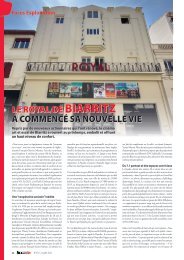Boxoffice-May.03.1952
You also want an ePaper? Increase the reach of your titles
YUMPU automatically turns print PDFs into web optimized ePapers that Google loves.
. . then<br />
. .<br />
by HAVILAND F. REVES<br />
VoNCESsiON SALES Can be given a substantial<br />
assist by the intelligent use of one<br />
of the world's greatest media of advertising—the<br />
American motion picture screen.<br />
Enough exhibitors have adopted it as a<br />
steady policy around the Motor city to<br />
show that it can be successful in many<br />
type of situations, including both indoor<br />
and outdoor theatres.<br />
ACHIEVES MAXIMUM IMPACT<br />
The situation is almost ideal from the<br />
advertising man's standpoint:<br />
1. Visual presentation, combined with<br />
audible, represents about the maximum<br />
impact upon the human senses—both are<br />
united in the effective use of the screen.<br />
2. A captive audience than cannot readily<br />
escape the message, except by closing<br />
both eyes and ears, is at hand.<br />
3. This audience is in an entertained, relaxed<br />
mood, and highly receptive to adequately<br />
phrased suggestion for a bit of the<br />
service a refreshment stand provides,<br />
whether food or drink, candy, gum, popcorn,<br />
or hot dogs, according to the house policy<br />
and the individual's taste and pocketbook.<br />
4. The cost is negligible. Since the screen<br />
and the mechanical facilities to produce the<br />
message are part of the basic investment<br />
and operating costs of the house, this advertising<br />
is virtually free.<br />
5. It is P.O.P.—Point of purchase advertising—the<br />
type that solid thinking in the<br />
field of promotion today considers one of<br />
the most desirable of all, as any current<br />
business paper of advertising will demonstrate.<br />
TRAILERS ARE 'NATURALS'<br />
The use of screen trailers is the obvious<br />
means to reach this audience and a variety<br />
of styles of presentation, appeals to various<br />
tastes, and choice of details-—are available<br />
Suggested<br />
That<br />
Sells<br />
If you're in the mood for food .<br />
Copy<br />
we<br />
invite you to visit our Snack Bar during the<br />
Intermission and look over the Goodies on sale!<br />
Everything from a Taste to o Feast! Condies .<br />
and Refreshments of every variety wait for you.<br />
Intermission! Time to get your Candy and<br />
Popcorn in our Lobby. It will add to your enjoyment<br />
of the show.<br />
Say, Folks . . . We<br />
have a wide selection of<br />
tempting, delicious Candy Bars . . . and<br />
toasted Popcorn in the lobby.<br />
fresh,<br />
Any attendant will make change for you. Get<br />
you Taste Treat Now.'<br />
Copy se!ectcd from National Screen Service<br />
trailers.<br />
REFRESHMENT SERVICE<br />
to the exhibitor. Those using It, as seen In<br />
one city, ranwe from the conservative. blKtlme,<br />
af f illiitod United Detroit circuit, to the<br />
rather new and highly enterprising Saul<br />
Korman circuit, from the smaller indepondciil<br />
hou.ses of thi' metropolis to the farflung<br />
upstate operation of the Butterficld<br />
circuit. Each does it in a little different<br />
way, usually one worked out by trial and<br />
error in his own operation.<br />
Perhaps the Community Theatres operation<br />
may serve as a pattern, because this<br />
circuit has long been known for its emphasis<br />
on operating a high standard type of<br />
refreshment service. Trailers are purchased<br />
from Filmack, and used in both indoor and<br />
drive-in theatres.<br />
VARIETY IS<br />
IMPORTANT<br />
Refreshment trailers are literally taken<br />
for granted as an essential part of sound<br />
show operation in this circuit, and it was<br />
almost surprising to a Community executive<br />
to learn that some exhibitors do not<br />
use them. Variety and lack of monotony<br />
are key points here. The circuit has a set<br />
of four different trailers, which are rotated<br />
between its various drive-ins. Each<br />
is run for about 30 days in succession<br />
then it is felt to be time for a change.<br />
Thus, each trailer should have a maximum<br />
of two runs a season in each theatre.<br />
Each trailer is individually designed<br />
from the ground up by Community, according<br />
to Adolph Goldberg, a partner in<br />
the circuit. Copy is worked up on such<br />
things as butter corn, the nationally advertised<br />
brands of candy sold, soft drinks,<br />
and other items handled in these theatres.<br />
The entire stand is covered in each trailer,<br />
but one or two items may be featured. The<br />
length is about two minutes.<br />
The trailers are spotted in different<br />
positions in the show, according to the current<br />
program. Having them come at different<br />
times also means greater audience<br />
impact, since the regular customers will not<br />
become used to expecting them at a given<br />
point and cease to pay attention to the<br />
screen almost on schedule.<br />
SELLING CHATTER FOR DRIVE-INS<br />
The trailers used in the drive-ins are<br />
usually silent, with a musical background.<br />
Occasionally a special record is cut for this<br />
purpose by some locally popular, radio disk<br />
.iockey, using his name on the platter. His<br />
copy consists of selling chatter, which can<br />
be put on the amplifier system while the<br />
trailer is running, or even run independently,<br />
as during the intermission.<br />
Indoors, the use of trailers is more restrained<br />
in Community. The feeling appears<br />
to be that drive-ins offer a natural<br />
opportunity to interest people in the purchase<br />
of refreshments, since they are in an<br />
outdoor, hunger-building environment with<br />
a bit of the park or carnival atmosphere,<br />
while the indoor theatre offers a more dignified<br />
variety of showgoing. Indoors, talking<br />
trailers are used, and are normally run<br />
about every 30 to 60 days only, to stimulate<br />
Continued on following page<br />
BOXOFFICE May 3, 1952 11

















